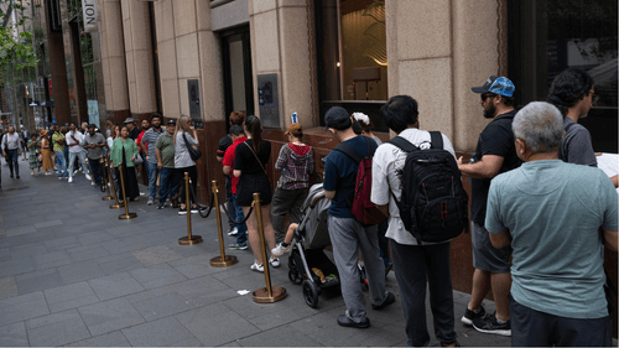The Gold and Silver of New Orleans
Greetings from New Orleans. I’m here for the 51st annual Investment Conference, formerly called the Gold Conference, founded half a century ago by the late Jim Blanchard. If you own gold, it’s because Jim fought tooth and nail in the 1960s and 70s to change U.S. law to allow private ownership.
And as you’ve undoubtedly noticed if you own gold – or if you go to buy some right now – the price is up-up-up. It’s higher than, say, six weeks ago, six months ago, a year ago, two years, and well… almost ever, allowing for a recent pullback in late October. And if you’re trying to figure things out along these lines, the Riverside Hilton is the place to be this week.

A view from the conference venue. BWK photo.
Housekeeping
Before I discuss some of what I’ve seen and heard here, I have a few quick items.
If you subscribe to Strategic Intelligence (and I hope you do!) be sure to check out the November issue which was published yesterday, Nov. 3rd. In the lead article Jim Rickards does a deep dive into President Trump’s effort to channel government support toward critical and even “strategic” industries; certainly, we’ve seen that occur in parts of the mining space, and there’s talk of moving government resources deeply into crypto.
Also in the November issue, my colleague Dan Amoss uncovers a hidden gem for subscribers. It’s a superb idea in the basic industrial space. Per Dan, this company is destined to do well – a multi-bagger – in the current effort to rebuild America’s manufacturing sector.
Meanwhile, Zach Scheidt presents an idea with strong upside in the real estate industry, and not just domestic but with international angles. As tariffs alter movements of goods, this company will benefit from new trade patterns; oh… and it pays out hard cash to investors as well.
Finally, I have an article that takes you into the iron mines of Minnesota, and then out onto the ore-boats of the Great Lakes. We’ll discuss geology, the deadly weather on Lake Superior, and how some people have made a lot of money over a very long time. Then we ponder how to protect wealth against unforeseen risk, particularly the risk of catastrophic loss. (Hint: gold.)
Now, back to NOLA and the Gold Conference.
One-Stop Shopping for Insight & Ideas
Of all the hard asset/hard money conferences out there, this one is the grandaddy. Reputedly, New Orleans is the world’s longest running, fully paid, gold-focused event, aside from, perhaps the Fort Knox Guards’ Alumni Association (if there is such a group; I’m just kidding on that).
This is four days of macroeconomic and hard asset discussion by a long list of insightful people: think of Rick Rule, Adrian Day, Brien Lundin, Peter Schiff, Nick Hodge… and many more. Plus, a large hall full of exhibitors, many of them up and coming names in the junior mining space, but familiar to anyone who follows gold-silver plays, and much else within the world of rock-kicking exploration and development. The upside leverage here is phenomenal.
In the 1990s, I attended this conference off and on, and this is my 20th year in a row except only 2020 when the event was forced online due to the pandemic. It’s one-stop-shopping for updates on a long list of companies that I follow closely, and many of which I’ve recommended to readers… and a number of which have delivered serious gains in the current up-cycle.
At any rate, as tourist boats and working vessels pass outside (see photos above and below), inside the Riverside Hilton we have much going on.

View from the conference. Riding high & empty, inbound for American cargo. BWK photo.
“Oh, NOW They Want to Buy!”
That line above is from Kerry Stevenson, the inimitable Australian commentator and CEO of the Australian Gold Conference, during a delightful conversation in the hallway, just before things kicked off.
Over many years, Kerry has banged the drum. “I said ‘buy gold’ at $1,500. Then at $2,000. And $2,500. Then $3,000. Then $3,500. And finally, when it hit $4,000 people were lined up outside the doors.”

People lined up to buy (and sell) gold in Sydney. Courtesy 9News.com.au.
Of course, many are lined up to sell as well. Times are tough, from the U.S. to Down Under. And more than a few people are taking old jewelry, tableware, belt buckles and whatever else has precious metal content down to the local buyer to swap out for cash or a bank transfer.
Closer to home, we have Dana Samuelson, of Austin, Texas and the American Gold Exchange. He’s a scholar of precious metal markets, and a noted, highly respected expert witness in a wide range of litigation matters. He has even consulted for the U.S. Treasury Department.
Dana explained how gold in the mid-$2,000s (aka “last year”) did not bring out waves of buyers or sellers. “Gold wasn’t on most peoples’ radar screens, even in the $2,000 range,” he said. Although, “Of course, we always have people who bring in coins or bullion because they just need cash right now to pay bills.”
“The U.S. has a stock market culture,” he explained. “Not a gold or silver culture.”
That is, most Americans simply don’t get the importance of storing wealth in precious metal. “We haven’t had a war on our soil since the 1860s, and we’ve never had a currency crash like other countries. And in the U.S., we’re fully accustomed to the dollar as the global reserve currency.”
Well, yes. In 1933 President Roosevelt confiscated the nation’s gold. In 1964 President Johnson tanked silver as coinage. And in 1971 President Nixon “closed the gold window,” as the saying goes. And that’s the basic, multigenerational background to America’s collective, large-scale psychology and social conditioning – i.e., the apparent “denial” – of gold and silver as true money.
But the rest of the world is different, said Dana. “Globally, there’s extraordinary demand for physical metal.”
With silver, according to Dana, “Industrial use has soared in recent years due to electronics and solar panels. And this has created a structural supply deficit. Sure, there’s metal out there, but it comes from reserve stocks to make up a deficit in output from mines and refineries. And the price has risen to clear markets.”
Meanwhile, per Dana, refineries are running full bore to melt, purify and “reshape” gold and silver from whatever sources, whether big bars from the mines, old coins from the vaults, or grandma’s antique candlesticks.
“In the olden days, like 2023 or 2024,” he said, “you might wait a week or ten days for your metal to get processed and you get paid. Now, it’s 10 or 12 weeks,” and that creates a cash flow problem for many bullion dealers.
Dana showed a series of slides to illustrate the volumes of precious metal that have been moving to and fro with three main destinations. London is one venue for global trade and settlements; although a significant amount of metal never leaves those vaults, and it just gets relabeled, depending on the nominal owner. Still, London has definitely suffered withdrawal “supply shocks” this year.
Then we have destinations #2 and #3, China and India, “the two most populous countries in the world, with cultures that respect and hold gold and silver as basic wealth.” China surged gold and silver imports after President Trump raised tariffs last April, and India began an import surge of silver after Trump imposed tariffs in late August. These new levels of demand contributed greatly to the rapid rise in precious metal prices this past summer and fall.
Dana pointed out that it’s relatively easy to move gold across vast distances. “Load it in the hold of an airplane and it’s on the other side of the world in 24 or 36 hours.”
Moving silver is more complex, however, because of the much higher numbers of ounces involved as compared with gold.
That is, we have silver issues based on global tariffs, which greatly complicate things. For example, unlike with airplanes it may take weeks or more to move large volumes of silver across an ocean on a cargo ship. And markets are concerned that silver in transit to the U.S., especially, might wind up getting hit with tariffs, which complicates the entire system of transfer, certainly to American vaults. And this has created issues even at the U.S. Mint, with regard to its supply of silver and output of bullion coins.
Prices: Up, Down or Steady?
At current price levels, Dana has a strong sense – based on his 45 years in the industry – that the downside price level for gold and silver is limited, absent a major market correction in which everything sells down; although in the aftermath of a sell-down, precious metals will also be among the first sectors to recover because they are always a key “safety” trade.
“The world wants fewer dollars and more metal,” Dana said. Reasons range from worries about U.S. sanctions and tariffs, to fundamental issues with U.S. governance. It’s the usual list of national embarrassments: massive deficits, rising debt, increasing interest payouts on debt, mercurial tariffs communicated via Truth Social, and widespread perceptions of overall political dysfunction. “And all of this was BEFORE September 30, and the now-month-long government shutdown,” Dana added.
According to Dana, silver in the high $40s-to-$50 range is “about right just now,” with low probability of a major pullback, and likely upside after the current supply and shipment situation consolidates.
Gold in the $4,000 range is also a good baseline number just now, according to Dana. Of course, we might also see a day when gold prices slump; a market selloff could happen for any of many reasons.
But more than likely, gold prices will remain range-bound until at least some political and economic dust settles; and then they’ll move upward again. Gold is a “safety trade,” noted Dana. And if gold prices slide, central banks are always on the prowl for metal. “They dollar-cost average, but at the end of the day they want the gold,” said Dana.
Plus, there’s a world out there filled with wealthy people, and flush businesses, banks and other organizations that simply want gold, versus dollars. And Dana “would not be surprised” to see gold continue an upward move into the mid-$7,000 range.
And with that… yes, there’s much more to say from New Orleans. But that’s all for now.
Except…. If you are interested in accessing the online version of the Gold Conference, with recordings of every talk and presentation, here’s the link.
Thank you for subscribing and reading. Best wishes…



Comments: